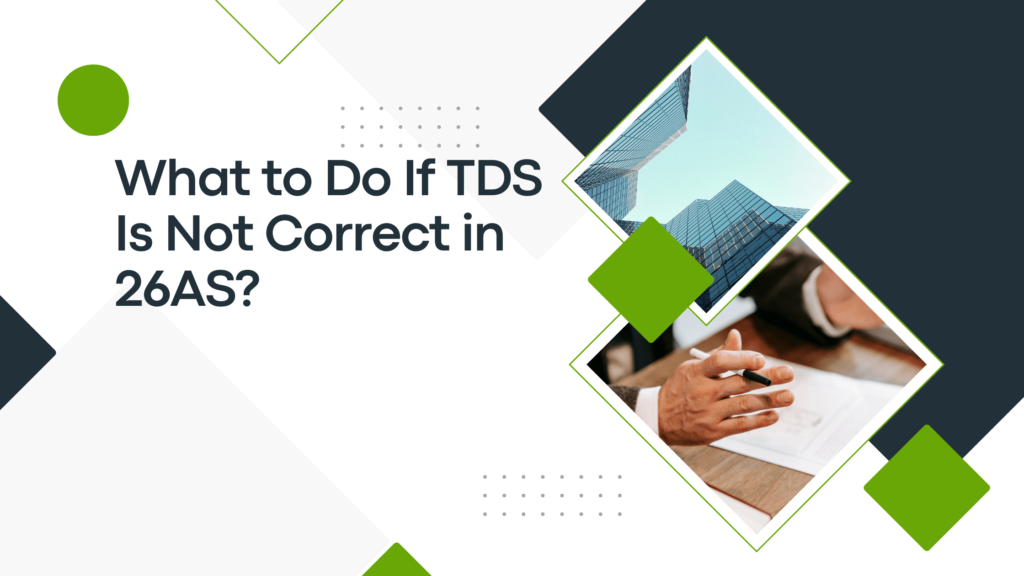Tax Deducted at Source (TDS) is a crucial aspect of tax compliance in India. Both Form 16 and Form 26AS are essential documents for filing Income Tax Returns (ITR). Form 16 is issued by employers detailing the TDS deducted from an employee’s salary, while Form 26AS is a consolidated tax statement that shows the TDS deducted and deposited into the government’s account. However, discrepancies between these forms can cause significant issues for taxpayers. Here’s what to do if your TDS is not correctly reflected in Form 26AS.
Understanding the Forms
Form 16: This certificate, issued by the employer under Section 203 of the Income Tax Act, 1961, details the amount of TDS deducted from an employee’s salary and deposited with the government.
Form 26AS: This consolidated tax statement includes details of TDS, tax collected at source (TCS), advance tax paid, self-assessment tax payments, and high-value transactions. It is crucial for verifying the accuracy of TDS credits while filing ITR.
Common Reasons for TDS Mismatch
Taxpayers often encounter discrepancies between the TDS details in Form 16 and Form 26AS. Understanding the common reasons behind these mismatches can help in resolving them efficiently. Here are the primary causes with examples:
- Non-filing of TDS Return by Deductor
- When the deductor (employer or payer) fails to file the TDS return, the deducted tax does not get reflected in Form 26AS. This is a common issue, especially with small businesses or new employers who might be unaware of compliance requirements. Example:- An employee receives their Form 16 showing TDS of ₹50,000 for the financial year. However, upon checking Form 26AS, the employee notices that the TDS amount is not updated. This could be due to the employer not filing the quarterly TDS returns (Form 24Q for salary TDS).
- Incorrect PAN/TAN Details
- Errors in the Permanent Account Number (PAN) of the employee or the Tax Deduction and Collection Account Number (TAN) of the employer can lead to mismatches. These details are critical for mapping the TDS to the correct taxpayer. Example:- An employer mistakenly records the employee’s PAN as AAAPL1234Q instead of AAAPL1234P in the TDS return. As a result, the TDS deducted appears under the incorrect PAN in Form 26AS, causing a mismatch with the TDS shown in Form 16.
- Incorrect Challan Details
- Challan Identification Number (CIN) is essential for TDS payment reconciliation. Errors in CIN, such as wrong BSR code, challan serial number, or date of deposit, can cause mismatches. Example:- An employer deposits TDS with the correct amount but enters the wrong BSR code of the bank branch where the tax was deposited. This error leads to the TDS payment not being correctly mapped to the employee’s PAN in Form 26AS.
- Omissions in TDS Return
- If the employer omits to include certain details in the TDS return, such as the employee’s PAN or the TDS amount, these omissions can cause discrepancies. Example:- An employee’s Form 16 shows a total TDS of ₹75,000, but only ₹50,000 appears in Form 26AS. Upon investigation, it is found that the employer did not include the last quarter’s TDS details in the return, leading to the mismatch.
- Wrong Assessment Year
- Entering the wrong assessment year in the TDS return can result in the tax being credited to a different year, causing discrepancies. Example:- An employer deducts TDS for the financial year 2022-23 but mistakenly files the TDS return for the assessment year 2022-23 instead of 2023-24. The TDS deducted appears in Form 26AS for the wrong year, leading to a mismatch.
- Incorrect Employee Details
- Mistakes in employee details, such as name or gender, can cause the TDS credit to be misallocated. Example:- An employee named “Rahul Kumar” has his name recorded as “Rohit Kumar” in the TDS return. The TDS credit does not get matched correctly in Form 26AS, causing a discrepancy.
- False or Excess TDS Claimed
- If an employer mistakenly claims a higher amount of TDS than actually deducted, it leads to mismatches in the records. Example:- An employer’s records show that they deducted ₹60,000 as TDS from an employee’s salary, but the actual amount deposited and reflected in Form 26AS is only ₹50,000. The mismatch creates issues for the employee when filing their return.
Steps to Resolve TDS Mismatches
Resolving a mismatch between the TDS reported in Form 16 and Form 26AS involves a series of steps. Below is a detailed guide with examples to help understand the process:
- Identify the Mismatch
- Compare the details in Form 16 (issued by the employer) and Form 26AS (available on the Income Tax Department’s website) to identify discrepancies. Example:- You receive your Form 16 for the financial year showing a TDS of ₹50,000. However, when you check Form 26AS, it only reflects ₹40,000. This indicates a mismatch of ₹10,000.
- Analyze the Reason for the Mismatch
- Common reasons for mismatches include:
- Non-filing of TDS return by the deductor.
- Incorrect PAN/TAN details.
- Errors in challan details.
- Omissions in TDS return.
- Incorrect assessment year.
- Incorrect employee details.
- False or excess TDS claimed.
- Example: You find that the mismatch of ₹10,000 is due to the employer not filing the TDS return for the last quarter.
- Common reasons for mismatches include:
- Contact the Deductor
- Inform your employer or the deductor about the discrepancy. Request them to correct and file a revised TDS return with accurate details. Example:- You contact your HR department and explain the issue. The HR confirms that the last quarter’s TDS return was not filed and promises to correct it.
- Follow Up with the Deductor
- Ensure that the deductor has filed the revised TDS return. This can take some time, so follow up regularly. Example:- After a week, you check back with HR. They confirm that the revised TDS return has been filed.
- Check for Updates in Form 26AS
- After the deductor files the revised return, it can take some time for the correction to reflect in Form 26AS. Monitor Form 26AS periodically to see if the correction has been updated. Example:- After a month, you log in to the Income Tax e-filing portal and check Form 26AS. The corrected TDS amount of ₹50,000 is now reflected.
- Submit an Online Response if Required
- If you receive a notice from the Income Tax Department regarding the TDS mismatch, respond online through the Income Tax e-filing portal. Select ‘Taxpayer is correcting data for Tax Credit Mismatch only’ and provide the relevant details. Example:- You receive a notice regarding the mismatch before the correction appears in Form 26AS. You respond online, selecting the appropriate option and mentioning that the revised TDS return has been filed by your employer.
- Approach the Assessing Officer
- If the mismatch persists or the deductor is unresponsive, approach the Assessing Officer (AO) with the necessary documents, including Form 16, payslips, and any correspondence with the deductor. Example:- Despite following up, the mismatch remains. You visit the local Income Tax office with your Form 16 and payslips and explain the situation to the AO. You also show proof of your communication with your employer.
- Present Judicial Decisions and CBDT Instructions
- While presenting your case to the AO, refer to relevant judicial decisions and CBDT instructions that support your claim for TDS credit based on Form 16. Example:- You refer to the Delhi High Court ruling in Sanjay Sudan Vs CIT, which states that employees should not be penalized for the employer’s failure to deposit TDS. You also mention CBDT Instruction No. 5/2013, which directs AOs to grant credit based on Form 16 after verification.
- Request for a Resolution
- Formally request the AO to rectify the mismatch and grant the correct TDS credit as per Form 16. Provide all supporting documents and judicial references. Example:- You submit a formal letter to the AO requesting resolution of the TDS mismatch. You attach copies of Form 16, relevant judicial decisions, and CBDT instructions, and you provide contact details for any follow-up.
Judicial Decisions Supporting Taxpayers
Several judicial decisions have supported taxpayers in cases of TDS mismatches:
Detailed Judicial Decisions on TDS Mismatch
- Sanjay Sudan Vs CIT (2023) HCC (Del) 237
- In this landmark judgment, the Delhi High Court ruled that an employee cannot be penalized for the employer’s failure to deposit deducted TDS. Sanjay Sudan, an employee of Kingfisher Airlines, faced repeated tax demands despite his salary being paid after deducting TDS. The court emphasized that once TDS is deducted from an employee’s salary, the responsibility to deposit it lies solely with the employer. The court set aside the tax demands raised against Sudan and directed the revenue to recover the deducted TDS from the employer instead (itatonline.org)
- Kartik Vijaysinh Sonavane Vs DCIT (2021) 132 Gujarat
- This case involved an employee of Kingfisher Airlines who faced similar issues with TDS mismatches. The Gujarat High Court ruled that TDS credit should be granted based on Form 16 issued by the employer, even if it does not match Form 26AS. The court emphasized that employees should not suffer due to the employer’s failure to deposit the deducted TDS and directed the tax authorities to grant the TDS credit as per Form 16 (ICMAI)
- Om Prakash Gattani (2001) 117 Taxman 549 Guwahati
- The Guwahati High Court ruled that taxpayers should not be penalized for their employer’s failure to deposit TDS. The court directed the tax authorities to grant TDS credit based on Form 16, reiterating that the taxpayer should not suffer for discrepancies that are beyond their control. This case set a precedent for protecting taxpayers from the consequences of the deductor’s non-compliance (IndianKanoon)
- Rakesh Kumar Gupta Vs Union of India (Allahabad High Court)
- In this case, the Allahabad High Court ruled that taxpayers should be given TDS credit based on Form 16/16A even if there is a mismatch with Form 26AS. The court highlighted that the responsibility to ensure TDS is correctly deposited lies with the deductor, and the taxpayer should not suffer for the deductor’s non-compliance (Allahabad HighCourt)
Important Instructions by CBDT
- CBDT Instruction No. 5/2013
- Following the Delhi High Court’s judgment in the case of Sanjay Sudan, the CBDT issued Instruction No. 5/2013. This instruction directs Assessing Officers to verify TDS claims made by taxpayers against Form 16/16A and grant credit if the TDS has been deposited. The instruction allows Assessing Officers to issue notices to deductors to correct discrepancies in their TDS returns. (ICAI)
- CBDT Office Memorandum F.No 275/29/2014-IT(B) dated 11.03.2016
- This memorandum directs tax officials to collect the tax from the deductor, not the deductee, in cases of TDS mismatch. It emphasizes that taxpayers should not be penalized for discrepancies caused by the deductor’s failure to deposit TDS (TaxGuru)
Tribunal Rulings
- ITAT Mumbai Bench (Kirtida Rameshchandra Chandarana Case)
- The ITAT Mumbai Bench held that denying TDS credit due to a mismatch between Form 26AS and Form 16/16A is insensitive and injudicious. The tribunal highlighted that such denials violate the CBDT Charter and the principles of natural justice, as taxpayers should not be penalized for discrepancies beyond their control (ITAT)
- ITAT Delhi Bench (Shri S. Ganesh vs ACIT)
- The ITAT Delhi Bench ruled that TDS credit must be granted based on the TDS certificates (Form 16/16A) even if there are mismatches with Form 26AS. The tribunal emphasized that the taxpayer cannot be held responsible for the deductor’s failure to deposit the TDS, and any such shortfall should be recovered from the deductor (ITAT)
Conclusion
If your TDS is not correctly reflected in Form 26AS, start by identifying the discrepancy and informing your deductor. If necessary, approach the Assessing Officer with evidence of the correct TDS details. Judicial precedents and CBDT instructions support the taxpayer’s right to TDS credit based on Form 16/16A. By following these steps, you can ensure that your tax returns are accurate and avoid undue tax liabilities.



